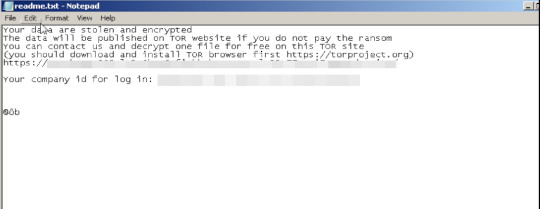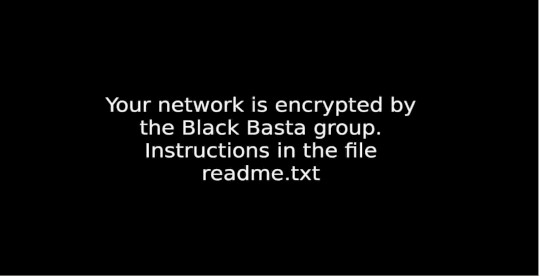Ransom.Win32.BASTACRYPT.THDBGBB
Ransom:Win32/Basta.C (MICROSOFT)
Windows


Threat Type: Ransomware
Destructiveness: No
Encrypted: No
In the wild: Yes
OVERVIEW
Downloaded from the Internet, Dropped by other malware
This Ransomware arrives on a system as a file dropped by other malware or as a file downloaded unknowingly by users when visiting malicious sites.
It drops files as ransom note. It avoids encrypting files with the following file extensions.
TECHNICAL DETAILS
576,512 bytes
EXE
Yes
27 Apr 2022
Encrypts files, Displays graphics/image, Displays message/message boxes, Modifies system registry
Arrival Details
This Ransomware arrives on a system as a file dropped by other malware or as a file downloaded unknowingly by users when visiting malicious sites.
Installation
This Ransomware drops the following files:
- %User Temp%\dlaksjdoiwq.jpg
- %User Temp%\fkdjsadasd.ico
(Note: %User Temp% is the current user's Temp folder, which is usually C:\Documents and Settings\{user name}\Local Settings\Temp on Windows 2000(32-bit), XP, and Server 2003(32-bit), or C:\Users\{user name}\AppData\Local\Temp on Windows Vista, 7, 8, 8.1, 2008(64-bit), 2012(64-bit) and 10(64-bit).)
It adds the following processes:
- %System%\cmd.exe /c C:\Windows\SysNative\vssadmin.exe delete shadows /all /quiet
- %System%\cmd.exe /c C:\Windows\System32\vssadmin.exe delete shadows /all /quiet
- %System%\cmd.exe /c bcdedit /set safeboot network
- %System%\cmd.exe /c C:\Windows\System32\bcdedit.exe /set safeboot network
- %System%\cmd.exe /c C:\Windows\SysNative\bcdedit.exe /set safeboot network
- %System%\cmd.exe /c shutdown -r -f -t 0
(Note: %System% is the Windows system folder, where it usually is C:\Windows\System32 on all Windows operating system versions.)
Autostart Technique
This Ransomware adds the following entries to allow itself to run on safe mode:
HKEY_LOCAL_MACHINE\SYSTEM\ControlSet001\
Control\SafeBoot\Network\
Fax
{default} = Service
Other System Modifications
This Ransomware adds the following registry entries:
HKEY_LOCAL_MACHINE\SOFTWARE\Classes\
.basta\DefaultIcon
{Default} = %User Temp%\fkdjsadasd.ico
It changes the desktop wallpaper by modifying the following registry entries:
HKEY_CURRENT_USER\Control Panel\Desktop
Wallpaper = %User Temp%\dlaksjdoiwq.jpg
It sets the system's desktop wallpaper to the following image:
Other Details
This Ransomware does the following:
- It encrypts files found in the following drive types:
- Fixed drive
- Network drive
- RAM Disks
- It modifies the following service:
- Service Name: Fax
- ImagePath = {Malware Path}\{Malware Filename}
- It will then restart the machine in safe mode
Ransomware Routine
This Ransomware avoids encrypting files with the following strings in their file name:
- OUT.txt
- readme.txt
- dlaksjdoiwq.jpg
- NTUSER.DAT
- fkdjsadasd.ico
It avoids encrypting files with the following strings in their file path:
- $Recycle.Bin
- Windows
- Local Settings
- Application Data
- Boot
It appends the following extension to the file name of the encrypted files:
- .basta
It drops the following file(s) as ransom note:
- {All Drive Folders}\readme.txt

It avoids encrypting files with the following file extensions:
- .basta
SOLUTION
9.800
17.530.04
27 Apr 2022
17.531.00
28 Apr 2022
Step 1
Before doing any scans, Windows 7, Windows 8, Windows 8.1, and Windows 10 users must disable System Restore to allow full scanning of their computers.
Step 2
Note that not all files, folders, and registry keys and entries are installed on your computer during this malware's/spyware's/grayware's execution. This may be due to incomplete installation or other operating system conditions. If you do not find the same files/folders/registry information, please proceed to the next step.
Step 3
Identify and terminate files detected as Ransom.Win32.BASTACRYPT.THDBGBB
- Windows Task Manager may not display all running processes. In this case, please use a third-party process viewer, preferably Process Explorer, to terminate the malware/grayware/spyware file. You may download the said tool here.
- If the detected file is displayed in either Windows Task Manager or Process Explorer but you cannot delete it, restart your computer in safe mode. To do this, refer to this link for the complete steps.
- If the detected file is not displayed in either Windows Task Manager or Process Explorer, continue doing the next steps.
Step 4
Disable this malware service
- Fax
Step 5
Delete this registry value
Important: Editing the Windows Registry incorrectly can lead to irreversible system malfunction. Please do this step only if you know how or you can ask assistance from your system administrator. Else, check this Microsoft article first before modifying your computer's registry.
- In HKEY_CURRENT_USER\Control Panel\Desktop value: Wallpaper data: %User Temp%\dlaksjdoiwq.jpg
- In HKEY_LOCAL_MACHINE\SOFTWARE\Classes\.basta\DefaultIcon value: %User Temp%\fkdjsadasd.ico
- In HKEY_LOCAL_MACHINE\SYSTEM\ControlSet001\Control\SafeBoot\Network\Fax value: data: Service
Step 6
Search and delete this file
- %User Temp%\dlaksjdoiwq.jpg
- %User Temp%\fkdjsadasd.ico
- {All Drive Folders}\readme.txt
Step 7
Reset your Desktop properties
Step 8
Scan your computer with your Trend Micro product to delete files detected as Ransom.Win32.BASTACRYPT.THDBGBB. If the detected files have already been cleaned, deleted, or quarantined by your Trend Micro product, no further step is required. You may opt to simply delete the quarantined files. Please check the following Trend Micro Support pages for more information:
Step 9
Restore encrypted files from backup.
Did this description help? Tell us how we did.



